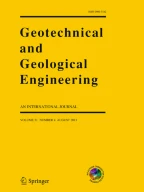Abstract
Soil water content measurement is crucial during compaction control of embankments. The current techniques used to measure the soil water content in the field are outlined, and their advantages and limitations are indicated. Most techniques require destructive sampling and yields late results, or involve expensive equipment and are hard to set up. Low-cost capacitive and resistive moisture sensors entered successfully in last decades in agronomy applications to automatize crops irrigation. The purpose of this study is to identify whether these sensors are reliable to be used in geotechnical engineering and, in particular, to what extent can they aid compaction control of embankments. Three resistive sensors and two capacitive sensors are tested on five types of soils prepared with a wide range of water contents. The experimental procedures are described, and the sensors output data are compared with water contents obtained from the oven-drying technique. A new device that allows calibration of the sensors on compacted soils is developed. Soils characteristics that can influence moisture measurement using capacitive and resistive sensors are also explored. Test results suggest that some of the sensors can estimate the soil water content on compacted fine grained soils, when proper calibration procedure is successfully achieved. Sensors accuracy tend to increase as the soil void ratio decreases. Such sensors may be useful for expedite measurements, especially, when later counter-prof is available, or when a wide interval for the water content is acceptable.













Similar content being viewed by others
Abbreviations
- Aka:
-
Also known as
- ASTM:
-
American society of testing materials
- CFHS:
-
Carbon fibre heated sensors
- C1, C2:
-
Capacitive sensors
- DC:
-
Direct current
- FBG:
-
Fibre bragg grating
- FDR:
-
Frequency domain reflectometry
- R1, R2, R3:
-
Resistive sensors
- TDT:
-
Time domain transmission
- TDR:
-
Time domain reflectometry
References
Abidin MHZ, Saad R, Ahmad F et al (2013) Soil moisture content and density prediction using laboratory resistivity experiment. Int J Eng Technol 5:731–735. https://doi.org/10.7763/ijet.2013.v5.652
Barapatre P, Patel JN (2019) Determination of soil moisture using various sensors forirrigation. Water Manage, pp 576–582
Berney ES, Kyzar JD, Oyelam LO (2012) Device Comparison for Determining Field Soil Moisture Content Geotechnical and Structures Laboratory. Vicksburg, MS
Bittelli M (2011) Measuring soil water content: a review. Horttechnology 21:293–300
Bogena HR, Huisman JA, Oberdörster C, Vereecken H (2007) Evaluation of a low-cost soil water content sensor for wireless network applications. J Hydrol 344:32–42. https://doi.org/10.1016/j.jhydrol.2007.06.032
Cai G, Zhang T, Puppala AJ, Liu S (2015) Thermal characterization and prediction model of typical soils in Nanjing area of China. Eng Geol 191:23–30. https://doi.org/10.1016/j.enggeo.2015.03.005
Cao D, Shi B, Zhu H et al (2018) A soil moisture estimation method using actively heated fiber Bragg grating sensors. Eng Geol 242:142–149. https://doi.org/10.1016/j.enggeo.2018.05.024
Charlesworth P (2005) Soil water monitoring: an information package, 2nd edn. Land Water Aust, Canberra
Cho WJ, Kwon S, Choi JW (2009) The thermal conductivity for granite with various water contents. Eng Geol 107:167–171. https://doi.org/10.1016/j.enggeo.2009.05.012
Correia dos Santos RN, Caldeira L, Maranha das Neves E (2017a) Experimental study on limitation of internal erosion in dams by upstream zones of well-graded soils. Geotechnique 67:491–502. https://doi.org/10.1680/jgeot.15.P.174
Correia dos Santos RN, Caldeira LMMS, Maranha das Neves E (2017b) Factors limiting the progression of internal erosion in zoned dams: flow limiting by an upstream material. J Geotech Geoenviron Eng. https://doi.org/10.1061/(ASCE)GT.1943-5606.0001576
Day RW (2001) Soil testing manual: procedures, classification data, and sampling practices, 1st edn. McGraw Hill Inc, New York
Dursun M, Ozden S (2011) A wireless application of drip irrigation automation supported by soil moisture sensors. Sci Res Essays 6:1573–1582
Espressif Systems (2018) ESP32 Series Datasheet. https://www.espressif.com/sites/default/files/documentation/esp32_technical_reference_manual_en.pdf
Espressif Systems (2019) ESP8266EX Datasheet. https://www.espressif.com/sites/default/files/documentation/ESP8266-DevKitC-V1.0_reference_design_0.zip
FEMA (2011) Filters for Embankment Dams. Best practices for design and construction
Haule J, Michael K (2014) Deployment of wireless sensor networks (WSN) in automated irrigation management and scheduling systems: a review. In: Proceedings of the 2nd Pan African international conference on science, computing and telecommunications (PACT 2014). pp 86–91
IAEA (2008) Field Estimation of Soil Water Content A Practical Guide to Methods. Instrumentation and Sensor Technology, Vienna
ICOLD (1994) Embankment dams: granular filters and drains. Int Comm Large Dams. https://doi.org/10.1017/CBO9781107415324.004
Kodikara J, Islam T, Sounthararajah A (2018) Review of soil compaction: history and recent developments. Transp Geotech 17:24–34. https://doi.org/10.1016/j.trgeo.2018.09.006
Lascano RJ, Sojka RE, Evett SR (2007) Soil water and monitoring technology
Malizia JP, Shakoor A (2018) Effect of water content and density on strength and deformation behavior of clay soils. Eng Geol 244:125–131. https://doi.org/10.1016/J.ENGGEO.2018.07.028
Matula S, Báťková K, Legese W (2016) Laboratory performance of five selected soil moisture sensors applying factory and own calibration equations for two soil media of different bulk density and salinity levels. Sensors 16:1912. https://doi.org/10.3390/s16111912
Modules A, Micro SP, Mega A (2015) Arduino IDE: introduction. [online] Available at: https://www.arduino.cc/en/Guide/Introduction 1–7. https://doi.org/10.1158/1078-0432.CCR-10-0207
Susha Lekshmi SU, Singh DN, Shojaei Baghini M (2014) A critical review of soil moisture measurement. Meas J Int Meas Confed 54:92–105. https://doi.org/10.1016/j.measurement.2014.04.007
Yeo TL, Sun T, Grattan KTV (2008) Fibre-optic sensor technologies for humidity and moisture measurement. Sensors Actuators A Phys 144:280–295. https://doi.org/10.1016/j.sna.2008.01.017
Acknowledgments
The help of experimental work carried out by the laboratorial staff at LNEC, António Cardoso, Henrique Graça and Celeste Guerreiro, is gratefully acknowledged. Our thanks also go to Joaquim Timóteo for the physical construction of the test device components.
Author information
Authors and Affiliations
Corresponding author
Additional information
Publisher's Note
Springer Nature remains neutral with regard to jurisdictional claims in published maps and institutional affiliations.
Rights and permissions
About this article
Cite this article
Teixeira, J., Correia dos Santos, R. Exploring the Applicability of Low-Cost Capacitive and Resistive Water Content Sensors on Compacted Soils. Geotech Geol Eng 39, 2969–2983 (2021). https://doi.org/10.1007/s10706-020-01672-0
Received:
Accepted:
Published:
Issue Date:
DOI: https://doi.org/10.1007/s10706-020-01672-0

